
Suppose an animal population oscillates sinusoidally from a low of 700 on January 1 and a high
of 900 on July 1. Find a formula for the population at any point in time during the year. Plot the function.
We found that the function is P(t)=800+100*sin[Pi/6(t-3)]
Start with the graph of sin(t):
> plot(sin(t),t=0..2*Pi);

Horizontally stretch the graph so that it's period is 12 months.
> plot(sin((Pi/6)*t),t=0..12);
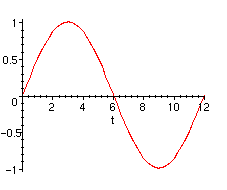
Next shift the graph 3 units to the right.
> plot(sin((Pi/6)*(t-3)),t=0..12);
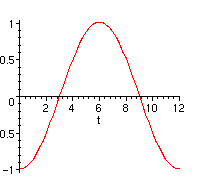
Next vertically stretch it by a factor of 100:
> plot(100*sin((Pi/6)*(t-3)),t=0..12);
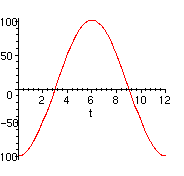
Next shift it vertically up 800 units:
> plot(800+100*sin((Pi/6)*(t-3)),t=0..12);
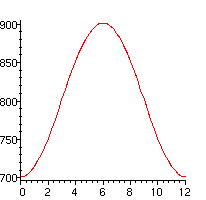
Finally let's change the range to remind ourselves that the graph doesn't start at the origin:
> plot(800+100*sin((Pi/6)*(t-3)),t=0..12,P=500..950);
>
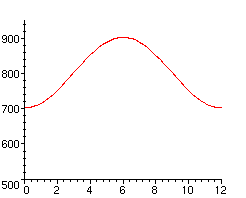
Let's plot the exponential. Note that unlike the graphing calculators, to get the number e we must type exp(1) NOT e^(1).
over the interval [-3,3]?
> plot(exp(x),x=-3..3);
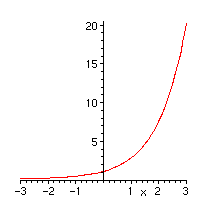
Now let's plot the graph of the natural logarithm.
> plot(ln(x),x=0..3);
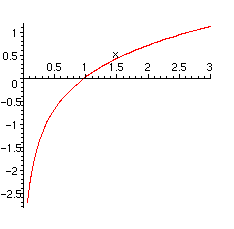
Maple can solve some equations analytically:
> eq:=x^2-5*x-11;
![]()
> sol:=solve(eq=2,x);
![]()
You can access the solutions by giving them names and using the square brackets as follows:
> sol[1];
![]()
> sol[2];
![]()
> solve(exp(3*x)=2,x);
![]()
Sometimes Maple will miss a solution. For instance if you take a rational function.
> rat_eq:=x^2+1/x-1/x^2;
![[Maple Math]](images2/lab2maple14.gif)
If you were to solve this by hand you would first get a common denominator and set the numerator equal to zero. Recall that Maple gets a common denominator using simplify:
> simplify(%);
![[Maple Math]](images2/lab2maple15.gif)
> soln:=solve(rat_eq=0);
![]()
This means that Maple cannot do it analytically. Note however that it arrived at the same expression that we got by finding a common denominator. So try the command fsolve to get approximate roots.
> soln:=fsolve(rat_eq=0,x);
![]()
You can check graphically that it missed a positive root.
> plot(rat_eq,x=-2..2,y=-20..20);

To find that root tell Maple to look in the interval (0,1):
> fsolve(rat_eq=0,x,x=0..1);
![]()
Note that Maple does not distinguish between log and ln.
> evalf(log(3));
![]()
> evalf(ln(3));
![]()
To get log base 10 of 3 you need to use the conversion formula. Basically divide by log(10):
> evalf(ln(3)/ln(10));
![]()
In class we solved the equation log(3x+2)+log(x-1)=1 analytically. Let's see if maple get the same answer:
> solve(log(3*x+2)+log(x-1)=log(10),x);
![]()
> evalf(%);
![]()
To get the inverse of a function with maple, first plot the graph of the original function and see if it passes
the horizontal line test:
> g:=x->6*x^3-3*x^2+x-3;
![]()
> plot(g(x),x=-5..5);
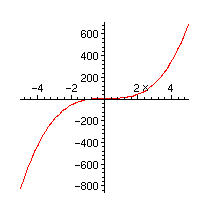
Next recall the method of finding the inverse. Interchange x and y and solve for y. You will get several answers some of which involve complex numbers like I. Ignore these for now. Just take the first answer.
> g_inv:=solve(x=g(y),y);
When you run the previous command you get a huge mess. Don't worry about understanding it now.
You should see that the graph of the original function and its inverse are related by a reflection in the line y=x:
> plot({g(x),g_inv},x=-10..10,y=-10..10,color=black);
